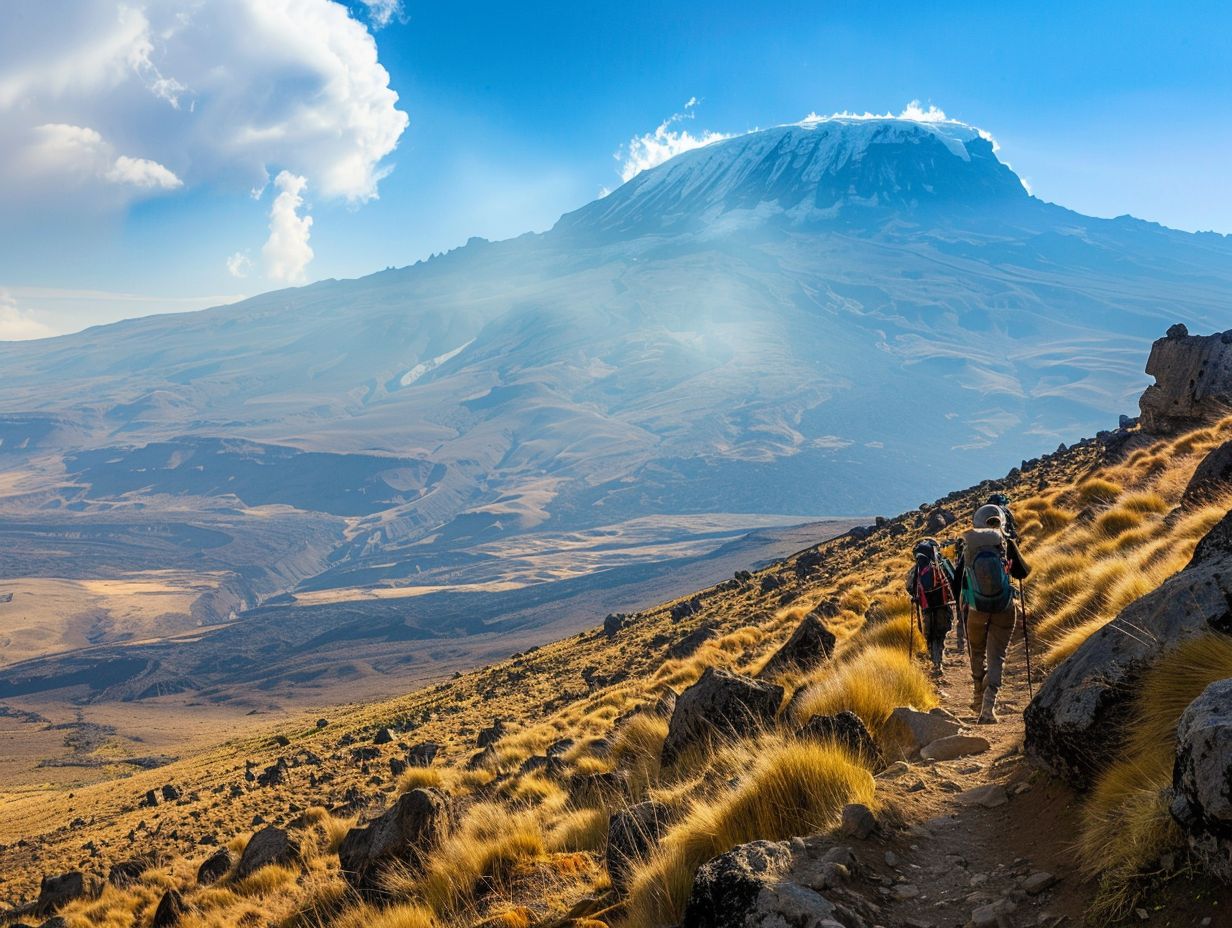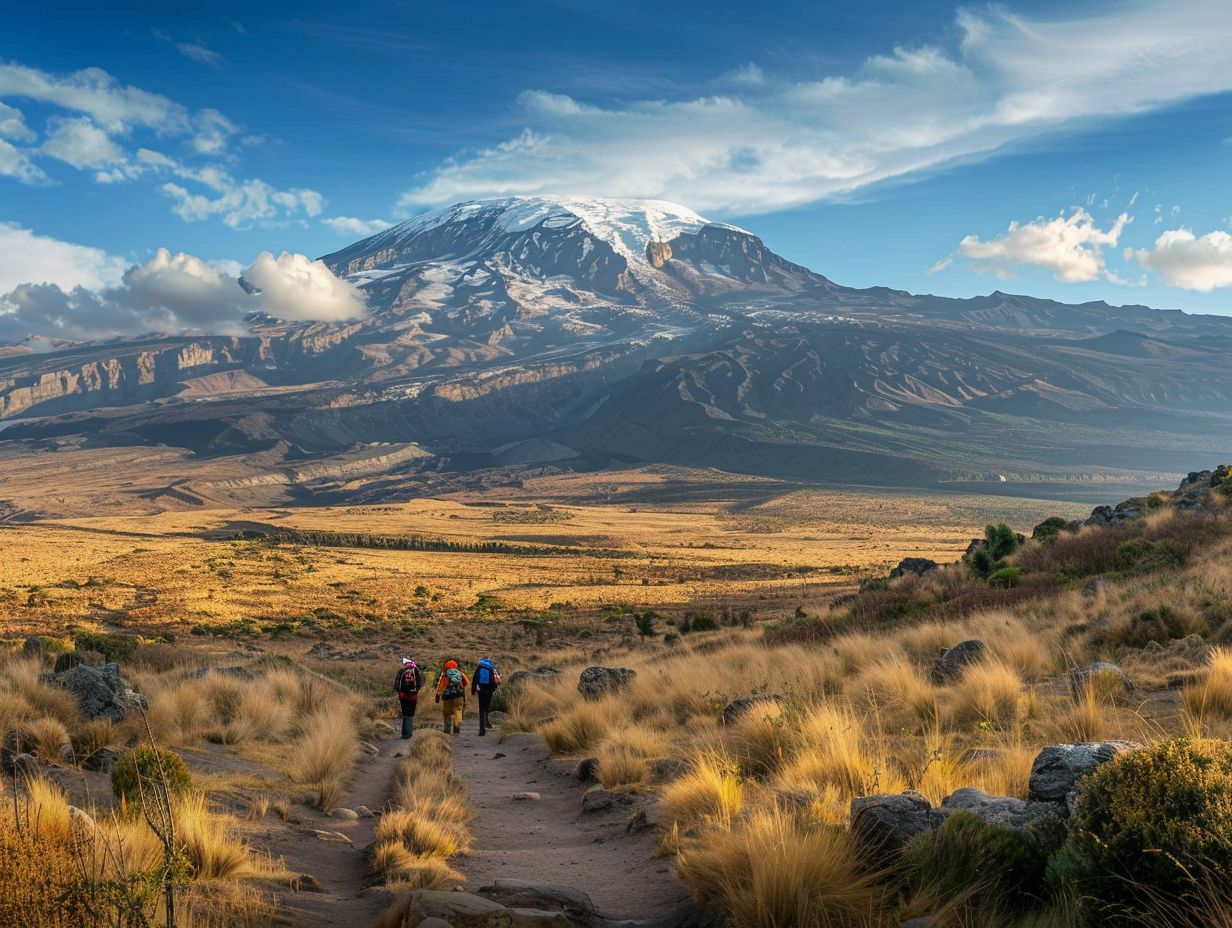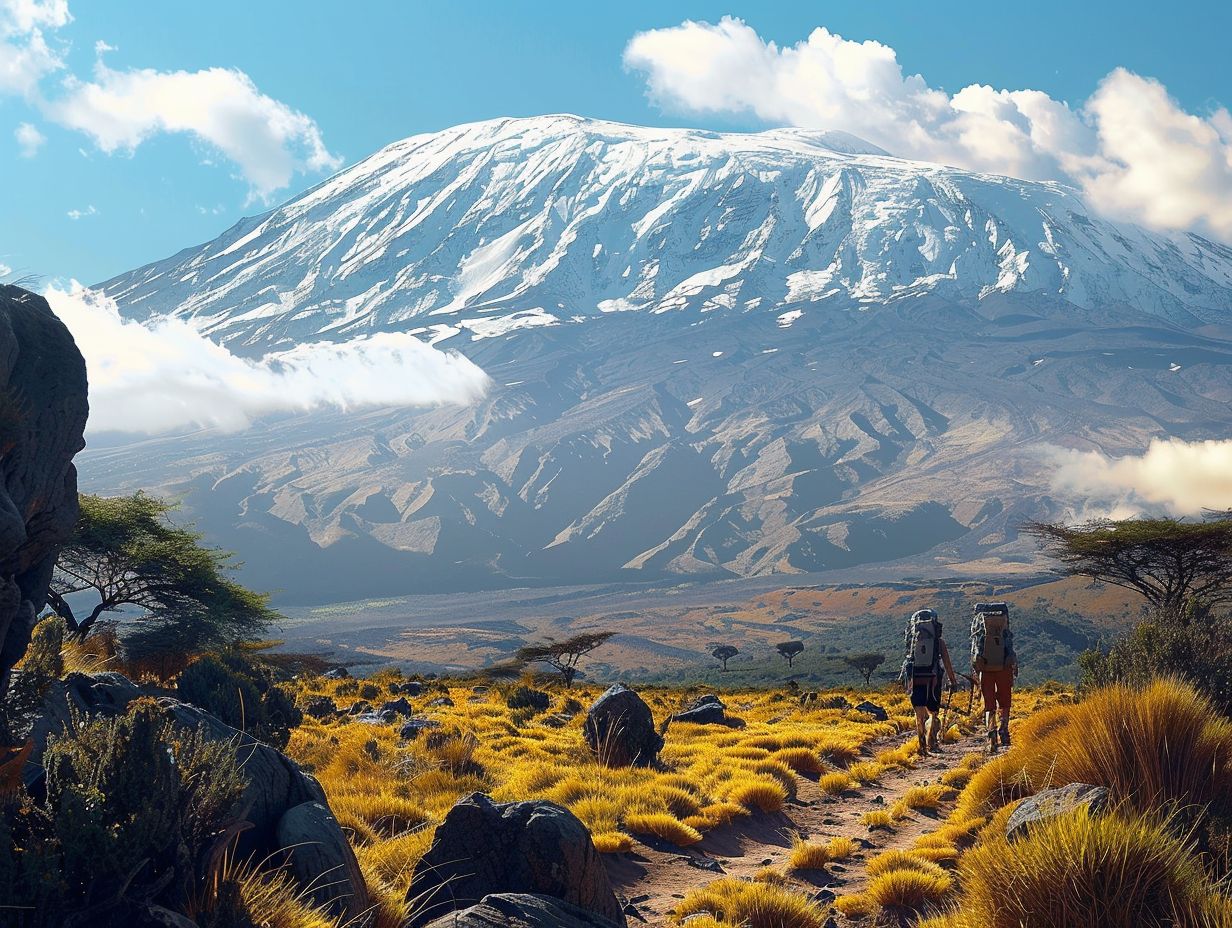
If you’re an adventurous soul seeking a challenge, then Kilimanjaro might just be the perfect destination for you. This iconic mountain, located in Tanzania, rises to an impressive elevation of 19,341 feet above sea level.
But why should you consider hiking Kilimanjaro? What are the benefits of embarking on this journey? And with multiple routes to choose from, each offering a unique experience, how do you decide which one to take?
Join us as we explore the wonders of Kilimanjaro, from its breathtaking views to the challenges that await those brave enough to conquer it.
Key Takeaways:

- Kilimanjaro is the highest mountain in Africa, located in Tanzania with an elevation of 19,341 feet.
- Hiking Kilimanjaro offers physical and mental benefits, including improved endurance and sense of accomplishment.
- The distance and time to complete each route vary, but the average hike covers around 35-45 miles and takes 6-8 days to complete.
How Many Miles is the Kilimanjaro Hike?
The distance of the Kilimanjaro hike varies depending on the chosen route, with routes ranging from approximately 35 to 45 miles in total length. Each route offers a unique journey with diverse landscapes and challenges.
For instance, the Marangu Route, known as the ‘Coca-Cola’ route for its popularity, covers around 42 miles. This route is favorable for those seeking comfortable accommodations with bunk beds in huts along the way, offering a more ‘civilized’ experience.
The Machame Route, on the other hand, is slightly longer at about 45 miles, characterized by its steep ascents and descents through various ecological zones.
Alternatively, the Lemosho Route spans approximately 42 miles, known for its scenic beauty and gradual acclimatization profile. The Rongai Route, averaging about 35 miles, provides a distinct trek from the north, offering different vistas and a quieter atmosphere.
What Is the Distance of Each Route?

Each Kilimanjaro route covers a specific distance, with variations in mileage ranging from approximately 35 to 45 miles depending on the chosen path. The distance traveled adds to the challenge and adventure of the climb.
For instance, the Marangu route, also known as the ‘Coca-Cola route,’ spans around 35 miles, offering a more gradual ascent compared to other trails. In contrast, the Machame route, approximately 40 miles long, presents a more challenging terrain with steep inclines and descents.
The scenic Lemosho route covers about 45 miles, renowned for its diverse landscapes and stunning views, making it a favorite among adventurers.
Each route not only differs in length but also showcases varying ecosystems and climatic zones, from lush rainforests to alpine deserts. The Kilimanjaro trekking experience is truly unique, as trekkers traverse these distinctive environments and get a taste of the diverse beauty that the mountain holds.
What Is the Average Time to Complete Each Route?
The average time to complete each Kilimanjaro route varies, with expeditions typically lasting between 5 to 9 days, depending on the chosen path, climber’s pace, and acclimatization needs. The duration of the trek impacts hikers’ experience and success rate.
Among the most popular routes, the Marangu route, known as the ‘Coca-Cola’ route, often takes about 5-6 days. In contrast, the Lemosho and Machame routes, offering more scenic views, usually extend over 6-7 days due to their longer distances. The Umbwe route, though challenging with steeper climbs, can be completed in about 5-6 days for experienced climbers.
Factors like physical fitness, altitude sickness, and weather conditions play a significant role in determining the trek duration. To improve chances of reaching the summit, climbers are advised to choose a route that aligns with their capabilities and prepare adequately for the journey.
What Are the Challenges of Hiking Kilimanjaro?
Hiking Kilimanjaro poses various challenges, including altitude sickness due to the mountain’s height, unpredictable weather conditions, and the physical demands of climbing a high-altitude peak.
Altitude sickness, also known as acute mountain sickness, can hit climbers at various points along the ascent, leading to symptoms like headaches, nausea, and dizziness. The drastic changes in elevation can affect the body’s ability to adapt to lower oxygen levels, requiring a slow and steady pace to acclimatize properly.
Plus altitude-related risks, climbers also have to navigate through ever-changing weather patterns on Kilimanjaro, which can shift rapidly from scorching sun to freezing temperatures and intense winds.
Trekking at high altitudes demands a considerable level of physical fitness and endurance, as the steep and rugged terrain, combined with the reduced oxygen levels, can challenge even the most experienced hikers. Climbers must be prepared for long hours of walking, carrying heavy gear, and enduring harsh conditions, all while pushing their bodies to perform in a challenging environment.
Altitude Sickness
Altitude sickness, a common concern for Kilimanjaro climbers, occurs due to rapid ascent and reduced oxygen levels at higher altitudes. It manifests through symptoms like headaches, nausea, and fatigue, requiring proper acclimatization strategies.
During rapid ascents, the body struggles to adjust to the decreasing oxygen availability, leading to the onset of altitude sickness. Physiological changes, such as increased breathing rate and heart rate, attempt to compensate for the lowered oxygen levels but can only do so much without proper acclimatization.
It is crucial for climbers to allow their bodies time to adjust to the changing altitude by gradually ascending and incorporating rest days in their itinerary. Hydration and a well-balanced diet aid in combating altitude sickness by supporting the body’s functions under stress.
Weather Conditions
Weather conditions on Kilimanjaro can be highly variable, ranging from hot and humid in the rainforest zone to cold and icy at higher altitudes. Climbers must be prepared for sudden changes in weather and adapt to diverse landscapes during the trek.
The fluctuating weather patterns on Kilimanjaro can present a unique challenge to climbers, with temperatures dropping significantly as they ascend through different climatic zones.
The rainforest zone, characterized by lush vegetation and warm temperatures, transitions into the heather moorlands where temperatures dramatically decrease. As climbers push further towards the summit, they encounter alpine deserts with freezing temperatures and icy terrain.
These climatic variations not only impact the comfort of climbers but also influence the landscape of the mountain itself. The icy conditions at higher altitudes contribute to the formation of glaciers and snowfields, shaping the dramatic scenery of Kilimanjaro. Proper gear such as insulated clothing, sturdy boots, and waterproof layers is essential to combat the diverse weather conditions.
Physical Demands
Hiking Kilimanjaro requires significant physical endurance and stamina due to the long hours of trekking, steep ascents, and high altitude conditions. Climbers must be prepared for the strenuous demands of the climb.
Given the challenging terrain and variable weather conditions, hikers need to be in top physical form to conquer the slopes of Mount Kilimanjaro. The continuous uphill trek requires muscles to work harder, especially in the thin air at higher altitudes, posing additional challenges to those attempting the climb.
It’s not just about endurance but also about mental resilience as you push yourself beyond your limits, facing fatigue and altitude sickness along the way. Proper training beforehand is essential to build up the strength and stamina needed to tackle this iconic peak.
How to Prepare for the Kilimanjaro Hike?
Preparing for a Kilimanjaro hike involves physical training to build endurance, acclimatization techniques to combat altitude sickness, and packing essential gear for the trek. Proper preparation is key to a successful climb.
In terms of physical training, it is crucial to focus on cardiovascular exercises, such as hiking, running, and biking, to enhance overall stamina and endurance. Strength training for the core and lower body can help in navigating the challenging terrain of Kilimanjaro.
Acclimatisations strategies include gradual ascent to higher altitudes, staying hydrated, and listening to your body for any signs of altitude sickness. Packing wise is essential, as you need to carry items like proper hiking boots, layered clothing for varying temperatures, a sturdy backpack, nutrition-packed snacks, and other essentials for a safe and comfortable journey.
Physical Training

Physical training is crucial for Kilimanjaro climbers to enhance their fitness, endurance, and strength for the demanding ascent. Activities like hiking, cardio workouts, and strength training can help prepare the body for the trek.
Engaging in regular training routines not only builds physical strength but also aids in mental preparation, which is equally vital for conquering the challenges posed by the Kilimanjaro climb.
Plus cardiovascular exercises and strength training, incorporating specific exercises to improve balance and flexibility can significantly benefit climbers. Yoga and Pilates, for instance, can enhance core stability and posture, essential for navigating rugged terrains.
Focusing on lower body workouts, such as squats and lunges, can target the muscles used extensively during uphill climbs, helping to prevent fatigue and injury. Consistency in training, gradual progression in intensity, and adequate rest periods are key elements for an effective training regimen.
Acclimatization
Acclimatization is essential for Kilimanjaro climbers to adapt to high altitudes, reduce the risk of altitude sickness, and increase the chances of summit success. Gradual ascent and rest days are key components of effective acclimatization.
When ascending Kilimanjaro, climbers traverse through various altitude zones, each presenting unique challenges due to reduced oxygen levels. Proper acclimatization allows the body to adjust to these conditions gradually, decreasing the likelihood of altitude-related illnesses such as acute mountain sickness (AMS) or high altitude pulmonary edema (HAPE).
Successful acclimatization not only enhances physical performance but also ensures a safer and more enjoyable climbing experience.
Packing Essentials
Packing essential gear and equipment is crucial for a successful Kilimanjaro trek. Items like proper clothing, sturdy footwear, hydration supplies, and high-altitude gear are essential for comfort and safety during the climb.
Proper clothing is vital for protecting against both the scorching sun during the day and the freezing temperatures at night. In addition, sturdy and supportive footwear will help navigate the varied terrain and reduce the risk of blisters.
Hydration supplies such as a durable water bottle or a hydration pack are necessary to stay hydrated at high elevations.
Climbers should also pack high-altitude gear like insulated jackets, gloves, and hats to combat the cold temperatures encountered as they ascend. Quality sunglasses and sunscreen are crucial for protecting against the intense UV rays reflected off the snow.
Frequently Asked Questions
How many miles is Kilimanjaro hike?
The total distance of the Kilimanjaro hike depends on the route chosen. On average, the shortest route is 32 miles and the longest is 45 miles.
What is the difficulty level of a Kilimanjaro hike?
The difficulty level of a Kilimanjaro hike varies depending on the route and your level of physical fitness. It is considered a challenging hike, with steep and rocky terrain, high altitude, and unpredictable weather conditions. Proper preparation and training are essential for a successful hike.
How long does it take to complete a Kilimanjaro hike?
The duration of a Kilimanjaro hike also depends on the route chosen. On average, it takes 7-9 days to complete the hike, including acclimatization days. The shortest route can take 5-6 days, while the longest can take up to 10-11 days.
What is the best time of the year to hike Kilimanjaro?
The best time to hike Kilimanjaro is during the dry season, which runs from June to October. This period offers the most stable weather conditions, making it easier to reach the summit. However, it is also the peak season, so the trails can be more crowded.
Do I need a permit to hike Kilimanjaro?
Yes, a permit is required to hike Kilimanjaro. It can be obtained from the Kilimanjaro National Park Authority or through a licensed tour operator. The permit fees vary depending on the route and duration of the hike.
Is it possible to hike Kilimanjaro without a guide?
No, it is not allowed to hike Kilimanjaro without a guide. All hikers must be accompanied by a certified guide, and group size is limited to a maximum of 12 people. This is for safety reasons and to protect the delicate ecosystem of the mountain.